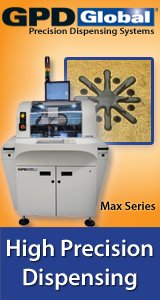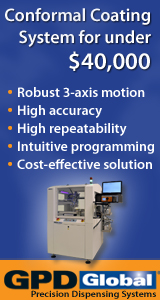| Yes l know this problem keeps cropping up on the forum but l've missed some of the follow-ups. | | Our problem is that the lifting only occurs on 3% of production so actually detecting an improvement is difficult. We're actually having to inspect 144 pins on each device underneath a microsope!! | | Our suspicions are on the aluminium-copper plate the pcb is mounted on. Unfortunately it exhibits a bi-metallic effect and bends slightly under reflow temperatures. | | Lead co-planarity is checked twice before placement. | | Does anyone think these other factors should be considered? | | -moisture contamination on device | -solderability of silver finish on pcb | -solder paste incompatibility (semi-aqueous) | -'float' from air circulating in reflow oven | | The device itself is a 144-pin, 20-thou pitch package. | | Cheers, | | | | Steve. | | | Steve,
Co-planarity of lead's can be a tricky one. What type of vision system / placement machine are you using to check it???
You've first got to prove that your part's are 'flat' before you place them. dont suppose you have a CMM lurking around the plant? thier granite bases are great for checking lead. If you know they're flat going in it's a good start.
I would have thought that moisture contamination was unlikely, you would at the very least see swelling of the device due to the pressure build up, to create the lifted lead's from this the pressure usually has got to be pretty big to distort the lead frame of the device hence the bulge, altho it may even popcorn..see further down the forum for that one.
I havent had much experience of a silver finish on a pcb so I dont know, but I would think that if your not using a silver loaded paste to keep the temperature's fiarly close..but then your lead's are likely to be tin lead or perhap's palladium so there are thermal mismatches all over for you to 'enjoy'. Why not use a std HASL finish?? it's only 20 tho, or if your gettinr real problems Nickle Gold? it shouldn't cost you any more for it and the flatness of the gold finish is usually great but you should use silver loaded paste with it to stop the leaching. Semi aqueous paste, umm, dunno, we'll need to ask the body of the hall on that, I'm strickly a no clean kinda guy. ha now the oven.... If your getting 'float' from circulating air ..then your oven set up is way off base. I've seen folk's getting problems with the air/N2 curtain at the front of some machines, we found 1 that we kept getting cap's moving all about the place on, someone had the input curtain up about 3/4's of the max!!! check it out..it's been known to happen. If the plating on the component is uneven between the back and the front you can get the lifting effect but component supplier's are alot better at getting this sorted. In term's of the profile, ramp rates aren't right then yeah you can get the likes of tombstones but I aint seen it happen to leads. Saying that if your paste deposit aint right or your placement is off so that the rest of the pin's are getting better paste contact then maybe certain lead's could lift.
So what would I look at..I tend to start at the beginning 9 just like the song) check that your getting paste inthe right places in the right amounts. then make sure your placement is bang on..using local fiducials ?, make sure that the placement pressure is right. Look at the profile and make sure that it meet's both the paste spec and the component spec's for ramp, soak , peak & reflow. I would look at the paste and make sure your using silver in it.
In term's of inspecting the lead's, i cant remember where I read it, but I'm sure I saw an article about looking at lead's, epescially lifted ones, under a blue light..dunno if it works but what the hell might be worth trying it
Hope my rambling's have helped, if not sorry you've had to read this drivel, but I'm sure the rest of the gang will point out all my flaw's..Moonman, Chrise, Dave..where are u ???
JohnW |
reply »
![]()
![]() Yes l know this problem keeps cropping up on the forum but...
- May 28, 1999
by
Yes l know this problem keeps cropping up on the forum but...
- May 28, 1999
by
![]()
![]() | Yes l know this problem keeps cropping up on the forum b...
- May 28, 1999
by
JohnW
| Yes l know this problem keeps cropping up on the forum b...
- May 28, 1999
by
JohnW
![]()
![]()
![]() | Yes l know this problem keeps cropping up on the forum b...
- May 30, 1999
by
davef
| Yes l know this problem keeps cropping up on the forum b...
- May 30, 1999
by
davef
![]()






